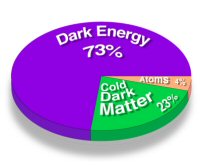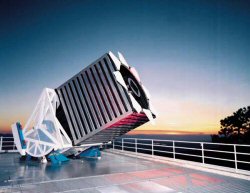Inquiring Minds
|
Physics at Fermilab main page | accelerators | collider experiments | neutrino physics | technology computing | theory | astrophysics | discoveries at Fermilab |
||||
|
||||
|
Results from recent particle physics research and its theoretical interpretations guide astrophysical thought in new directions. At the same time, astrophysical observations and computations have provided evidence for such phenomena as dark matter, invisible mass that cannot be accounted for by elementary particles thus far identified in laboratory experiments, and dark energy, a mysterious force that is driving the universe apart. The particle physics and astrophysics communities share the need for new measurements, new mathematical approaches and powerful computers for simulations. Fermilab's 50 theoretical and experimental astrophysicists are actively involved in several astrophysical projects, with research focused on understanding the nature of dark matter and dark energy. These projects will also shed light on the mass of neutrinos and on inflation, the mechanism believed to be responsible for structure in the universe.
Fermilab physicists search for dark matter directly through the Cryogenic Dark Matter Search, an experiments located deep underground in Minnesota's Soudan Mine. The CDMS collaboration looks for weakly-interacting massive particles, or WIMPS, by directly detecting their interactions with ordinary matter. The Pierre Auger Observatory studies the universe's highest-energy particles. The observatory, currently being built on a vast plain in western Argentina, will use a collection of particle detectors spread over an area the size of Rhode Island to measure ultra-high-energy cosmic rays, particles that hit the earth's atmosphere with energies up to 100 million times higher than the Tevatron produces. Fermilab scientists and other Auger Observatory collaborators hope to solve a decades-old mystery by determining the origin of these high-energy cosmic rays. Fermilab scientists also contribute to research and development for two future experiments. The Supernova/Acceleration Probe is a space-based telescope designed to reveal the nature of the dark energy causing the acceleration of the expansion of the universe. If approved and funded, SNAP will measure thousands of supernova over a wide range of distances to determine the expansion history of the universe over the last 10 billion years. SNAP will also use gravitational lensing, the distortions of distant galaxies by foreground matter in other galaxies and clusters, as another measure of distances and growth of universal structure. Fermilab researchers are playing a leading role in the Dark Energy Survey, which will make precision measurments of dark energy using four independent astronomical techniques. The DES will use the world's biggest CCD camera mounted on a four-meter telescope at the Cerro Tololo Inter-American Observatory in Chile to measure the history of the expansion rate of the universe.
Homepages of: |
| last modified 8/31/2004 email Fermilab |
FRLsDFx9eyfrPXgV




